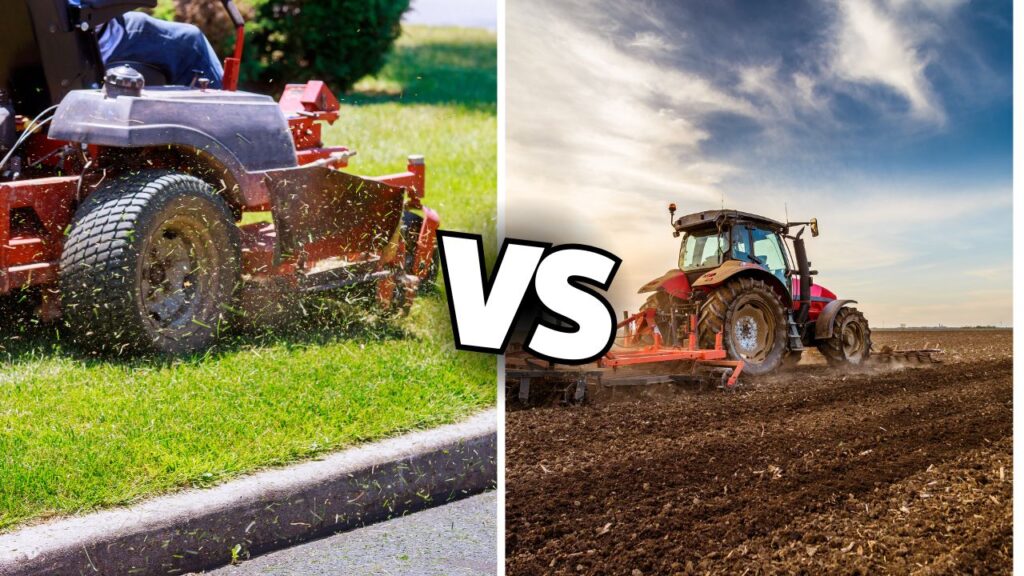Lawn Tractor vs Garden Tractor: Which One Should You Choose?

This is especially the case when it comes to mowing your lawn: a lawn tractor vs garden tractor comparison is a must. Although in appearance, both types of tractors may look identical, they are built for different purposes as well as used in different conditions.
That is where knowing some basic distinctions, characteristics, and capabilities of each type will help you make the right choice.
Here, we look at how lawn tractors and garden tractors differ: which is best for which, a breakdown of the machines, and advice on how to make the right choice for your lawn.
Understanding the Difference: Lawn Tractor vs Garden Tractor
These too can be differentiated based on their power, size and the work that they have been designed to handle. Okay let’s first bring the differences into perspectives.
Lawn Tractor
The lawn tractors are constructed mostly for lateral mowing that is for moving back and forth in large expanses of grass. Today’s models are compact, relatively small, and directly available with lower horsepower engines, which is well suitable for mowing residential lawns.
As such, although lawn tractors can tow simple light-duty carts, they are primarily suited to mowing, and are an excellent choice for homeowners who require only moderate lawn maintenance.
Key Features of Lawn Tractors:
- Horsepower: Typically ranges from 18 to 25 HP, sufficient for cutting grass and light towing.
- Deck Size: Mower deck sizes range from 42 to 54 inches, suitable for medium-sized lawns.
- Attachments: Limited to basic accessories like baggers, mulching kits, and small trailers.
- Terrain: Best suited for flat or slightly uneven terrain.
Garden Tractor
Garden tractors are larger, heavier, and more powerful than lawn tractors. They can handle a wider range of tasks beyond mowing, such as tilling, plowing, and hauling heavy loads.
With robust engines and stronger frames, garden tractors are designed for serious gardening and landscaping tasks, making them the go-to choice for larger properties, farms, or homesteads.
Key Features of Garden Tractors:
- Horsepower: Typically ranges from 24 to 30 HP, providing more torque for heavy-duty tasks.
- Deck Size: Mower deck sizes range from 50 to 60 inches, allowing for faster mowing of larger areas.
- Attachments: Can accommodate a wide variety of heavy-duty attachments, including tillers, snowblowers, and cultivators.
- Terrain: Capable of handling rugged terrain, hills, and even small plots of farmland.
Features and Benefits Comparison
Here’s a quick comparison table to help you see the major differences between lawn tractors and garden tractors:
| Feature | Lawn Tractor | Garden Tractor |
| Engine Power | 18–25 HP | 24–30+ HP |
| Deck Size | 42–54 inches | 50–60 inches |
| Tasks | Mowing, light towing | Mowing, plowing, tilling, heavy hauling |
| Attachments | Limited (baggers, trailers, mulching kits) | Wide range (tillers, plows, snowblowers, etc.) |
| Weight | Lighter, easier to maneuver | Heavier, designed for tougher tasks |
| Terrain | Best for flat or slightly uneven terrain | Handles rugged terrain and slopes |
| Price Range | More affordable, starting around $1,500 | Higher cost, starting around $3,000 |
When to Choose a Lawn Tractor
Lawn tractors are ideal for homeowners with moderate mowing needs who have flat or slightly uneven lawns. If your primary task is to maintain your lawn and you occasionally need to pull a small cart or spread grass seed, a lawn tractor will suit you well.
Best Use Cases for Lawn Tractors:
- Mowing: Regular grass cutting on residential lawns.
- Light-Duty Towing: Pulling small carts for gardening supplies or yard waste.
- Limited Space: Smaller size makes them easier to store in smaller garages or sheds.
Pros:
- More affordable than garden tractors.
- Lightweight and easier to maneuver in tight spaces.
- Efficient for flat lawns and basic yard work.
Cons:
- Limited versatility in terms of attachments and tasks.
- Not built for rugged terrain or heavy-duty jobs.
- Smaller mowing deck, making it less efficient for large properties.
When to Choose a Garden Tractor
Garden tractors are the best option for people who own large properties or have a variety of landscaping tasks to handle. If you need a machine that can do more than just mow—like tilling soil, plowing snow, or hauling heavy loads—then a garden tractor is the way to go. These tractors are built for power and durability, making them ideal for both lawn care and serious gardening projects.
Best Use Cases for Garden Tractors:
- Large Properties: Perfect for homeowners with large lawns, gardens, or small farms.
- Multiple Attachments: Suitable for tasks like plowing, tilling, and snow removal.
- Rugged Terrain: Handles hilly or uneven terrain with ease.
Pros:
- Versatile, with the ability to handle a wide range of tasks.
- More powerful engine and larger deck for faster work.
- Durable, heavy-duty construction for long-term use.
Cons:
- Higher upfront cost compared to lawn tractors.
- Heavier and more difficult to maneuver in tight spaces.
- Requires more storage space due to its larger size.
Installation and Maintenance Tips for Tractors
Once you’ve decided whether a lawn or garden tractor is right for you, it’s important to understand how to properly install and maintain your tractor and its attachments. Here are some tips to get started:
Installation Guide: Installing a Mower Deck
- Preparation
- Ensure your tractor is on level ground, with the engine off and parking brake engaged.
- Position the Deck
- Slide the mower deck under the tractor, ensuring the belt and connections are aligned.
- Attach the Belt
- Loop the mower belt around the engine pulley, ensuring the belt sits properly in the grooves.
- Connect the Hangers
- Attach the deck hangers to the tractor’s frame, ensuring the deck is level on both sides.
- Tighten Connections
- Secure all fasteners and connections, ensuring everything is tight before operation.
- Test the Deck
- Start the tractor and engage the deck to ensure proper operation.
Maintenance Tips for Lawn and Garden Tractors
To keep your tractor in peak condition, follow these maintenance tips:
- Change Oil Regularly: Refer to the manufacturer’s guidelines for oil change intervals to keep your engine running smoothly.
- Check and Replace Filters: Clean or replace air and oil filters regularly to maintain performance.
- Sharpen Blades: Dull blades will tear grass rather than cut it, leading to an uneven lawn.
- Inspect Tires: Check tire pressure regularly and inspect for any signs of wear or damage.
- Clean the Undercarriage: Grass clippings and debris can build up under the deck, causing rust and reduced performance.
Conclusion: Lawn Tractor or Garden Tractor?
Choosing between a lawn tractor vs garden tractor depends on your specific needs. If you have a smaller yard with basic mowing tasks, a lawn tractor is more than sufficient. However, if you have a larger property or need your tractor to perform more heavy-duty tasks like plowing or hauling, a garden tractor offers the versatility and power you need.
No matter which one you choose, proper maintenance and care will ensure that your tractor lasts for many years, keeping your property looking its best.
Explore the ultimate guide to the Fordson Major Diesel Tractor—learn more here!
